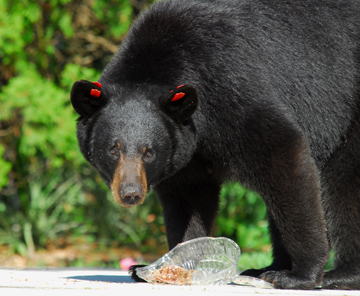
New management plan will include measurable objectives regarding bear populations, habitat, citizen education and outreach, and human-bear conflicts
After dwindling to as few as 300 bears in the 1970s, the Florida black bear population has rebounded to an estimated 3,000 bears today. Bears and their cubs roam forests and swamps from Eglin Air Force Base in the Panhandle to Ocala National Forest in the state’s midsection and Big Cypress National Preserve in Southwest Florida.
The Florida Fish and Wildlife Conservation Commission (FWC), which worked with its partners to increase the state’s black bear population, today released a new draft management plan for the bear and is asking for public input. Both a summary of public feedback and the draft plan will go before the Commission at its February 2012 meeting.
“The Florida black bear is truly a conservation success story. Bear populations have clearly benefited from broad public support and diligent conservation efforts across Florida, particularly in those communities where black bears have become more common,” said FWC Executive Director Nick Wiley. “We welcome the public’s thoughts on how to best continue our bear conservation efforts in the future, as both our human and bear populations expand.”
The goal of the draft management plan is to “maintain sustainable black bear populations in suitable habitats throughout Florida for the benefit of the species and people.” It includes measurable objectives regarding bear populations, habitat, citizen education and outreach, and human-bear conflicts.
The Florida black bear currently does not meet the criteria of being at high risk of extinction, based on the FWC’s Biological Status Review on the species completed in early 2011. When a bear management plan is approved, the bear will no longer be on the state’s list of threatened species. A similar process was followed for the bald eagle, which is no longer listed as a state threatened species but is carefully managed through specific conservation measures established under an FWC management plan.
The FWC is seeking public input on the draft bear management plan. The open process will include four public workshops: Bristol (Nov. 22), Naples (Nov. 29), Deland (Dec. 6), and Gainesville (Dec. 13). Go to MyFWC.com/Bear to access workshop details, read the plan and comment online.
The draft bear management plan includes:
§ Establishment of seven bear management units (BMUs) to provide localized bear management and public involvement appropriate to the area, from about 1,000 bears in the Central BMU, which includes Ocala National Forest, to about 20 bears in the Big Bend BMU, which includes Chassahowitzka National Wildlife Refuge.
§ A section on the history of bear hunting in Florida. A bear hunt is not proposed in the plan. Currently, Florida black bears may not be hunted, harmed or killed, and similar prohibitions would continue under a rule proposed in the plan.
§ Creation of “Bear Smart Communities” in areas of high bear activity. Human-bear conflicts are on the rise in Florida. In 2010, the FWC received more than 4,000 calls from citizens about bears. In the past 10 years, more than half of those calls were related to bears rummaging through garbage. A “Bear Smart Community” would involve residents, local governments, businesses and schools in changing people’s behaviors to reduce human-bear conflicts.
“People’s involvement in conserving bears is critical,” Wiley said. “For example, employees at the U.S. Air Force’s Hurlburt Field have an active bear education program for base residents and recently acquired hundreds of bear-proof garbage cans. Those efforts dramatically reduced the number of bears wandering into their neighborhoods.”
Black bears are generally shy and nonaggressive toward humans. But bears can smell food from more than a mile away and so are tempted to leave forests and swamps to dine on garbage and pet food that is left outdoors and unsecured.
The diet of Florida black bears is mostly vegetarian, with 15 percent insects, and 5 percent animal matter. The bear’s menu includes saw palmetto, acorns, ferns, blackberries, bees, alligator eggs, armadillo and opossum. Male bears typically weigh between 250 and 400 pounds; females are smaller, weighing 125 to 250 pounds. At birth, a bear cub is about the size of a can of soda and weighs less than a pound.
Conservation of Florida wildlife habitats on both public and privately owned lands helped ensure the rebounding bear population had room to grow. However, expected future loss of large forests is the major long-term challenge to maintaining black bears in a growing state of nearly 19 million people. The adult male black bear rambles over a 60,000-acre range; the female’s range is 15,000 acres. The more immediate danger to a black bear is crossing the road. Being hit by a car or truck is the major cause of known bear deaths in the state, with 158 bears killed or euthanized after being injured on highways in 2010.
The Florida black bear is among the 62 wildlife species that soon will join the list of Florida species, like the bald eagle, already under an FWC management plan. Florida’s new threatened species conservation model requires that management plans be created for all species that have been state-listed and then updated at specified intervals. Those management plans give citizens an active role in Florida’s efforts to conserve its diverse wildlife for future generations.
Suggestions on revising the bear plan will be accepted online through Jan. 10, 2012, at MyFWC.com/Bear, where more information also is available on the Florida black bear.
